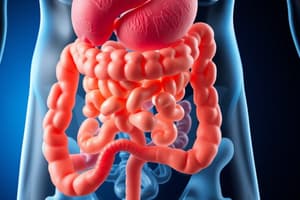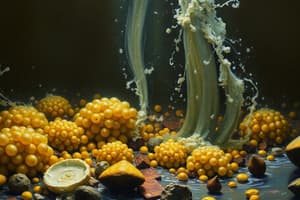Podcast
Questions and Answers
Which of the following processes is responsible for preventing nutrient deprivation due to the non-selective nature of ultrafiltration?
Which of the following processes is responsible for preventing nutrient deprivation due to the non-selective nature of ultrafiltration?
- Excretion
- Egestion
- Secretion
- Selective reabsorption (correct)
What is the primary function of the adipose capsule that surrounds the kidney?
What is the primary function of the adipose capsule that surrounds the kidney?
- Regulating blood pH
- Producing urine
- Filtering blood to remove waste
- Absorbing shock and providing physical support (correct)
Which of the following correctly describes the difference in blood composition between the renal artery and the renal vein?
Which of the following correctly describes the difference in blood composition between the renal artery and the renal vein?
- The renal artery has higher glucose and lower oxygen compared to the renal vein.
- The renal artery has higher nitrogenous wastes and lower carbon dioxide compared to the renal vein. (correct)
- The renal artery has lower glucose and higher oxygen compared to the renal vein.
- The renal artery has lower nitrogenous wastes and lower oxygen compared to the renal vein.
Why does a high hydrostatic blood pressure in the glomerulus enhance ultrafiltration?
Why does a high hydrostatic blood pressure in the glomerulus enhance ultrafiltration?
How do the structural differences between the afferent and efferent arterioles maximize ultrafiltration efficiency?
How do the structural differences between the afferent and efferent arterioles maximize ultrafiltration efficiency?
What structural feature of the proximal convoluted tubule greatly increases its capacity for reabsorption?
What structural feature of the proximal convoluted tubule greatly increases its capacity for reabsorption?
In which part of the nephron is water reabsorbed via osmosis due to the presence of aquaporins?
In which part of the nephron is water reabsorbed via osmosis due to the presence of aquaporins?
What is the primary role of the loop of Henlé in urine formation?
What is the primary role of the loop of Henlé in urine formation?
Why is the thick ascending limb of the Loop of Henlé rich in mitochondria?
Why is the thick ascending limb of the Loop of Henlé rich in mitochondria?
Which of the following scenarios would result in the release of ADH (Anti-Diuretic Hormone)?
Which of the following scenarios would result in the release of ADH (Anti-Diuretic Hormone)?
How does ADH (Anti-Diuretic Hormone) influence water reabsorption in the kidneys?
How does ADH (Anti-Diuretic Hormone) influence water reabsorption in the kidneys?
Which of the following best describes the term 'osmolarity'?
Which of the following best describes the term 'osmolarity'?
What is the underlying cause of central diabetes insipidus?
What is the underlying cause of central diabetes insipidus?
In hemodialysis, what properties of the cellophane tubings within the dialyzer facilitate the removal of waste products from the blood?
In hemodialysis, what properties of the cellophane tubings within the dialyzer facilitate the removal of waste products from the blood?
Why is counter-current flow used in dialysis?
Why is counter-current flow used in dialysis?
How does creating an arteriovenous fistula or graft improve the efficiency of hemodialysis?
How does creating an arteriovenous fistula or graft improve the efficiency of hemodialysis?
What is the primary difference between Type 1 and Type 2 Diabetes Mellitus regarding insulin production?
What is the primary difference between Type 1 and Type 2 Diabetes Mellitus regarding insulin production?
What effect would damage to the glomerulus have on kidney function?
What effect would damage to the glomerulus have on kidney function?
Which of the following is NOT a function of the human urinary system?
Which of the following is NOT a function of the human urinary system?
A patient is experiencing a decrease in blood osmolarity. How would the body respond to restore homeostasis?
A patient is experiencing a decrease in blood osmolarity. How would the body respond to restore homeostasis?
Flashcards
What is excretion?
What is excretion?
The removal of metabolic wastes and toxic substances to prevent buildup of toxins.
What does the skin excrete?
What does the skin excrete?
Waste products: Excess water, mineral salts, and urea.
What do the lungs excrete?
What do the lungs excrete?
CO2, O2, and N2.
What does the liver excrete?
What does the liver excrete?
Signup and view all the flashcards
What do the kidneys excrete?
What do the kidneys excrete?
Signup and view all the flashcards
What is metabolism?
What is metabolism?
Signup and view all the flashcards
What is catabolism?
What is catabolism?
Signup and view all the flashcards
What is anabolism?
What is anabolism?
Signup and view all the flashcards
What is secretion?
What is secretion?
Signup and view all the flashcards
What is egestion?
What is egestion?
Signup and view all the flashcards
What is the urinary system's function?
What is the urinary system's function?
Signup and view all the flashcards
What is the adipose capsule?
What is the adipose capsule?
Signup and view all the flashcards
What is the renal cortex?
What is the renal cortex?
Signup and view all the flashcards
What is the renal medulla?
What is the renal medulla?
Signup and view all the flashcards
What happens during ultrafiltration?
What happens during ultrafiltration?
Signup and view all the flashcards
What gets filtered into the Bowman's capsule?
What gets filtered into the Bowman's capsule?
Signup and view all the flashcards
How is ultrafiltration rate maximized?
How is ultrafiltration rate maximized?
Signup and view all the flashcards
What is selective reabsorption?
What is selective reabsorption?
Signup and view all the flashcards
Why is selective reabsorption important?
Why is selective reabsorption important?
Signup and view all the flashcards
What are aquaporins?
What are aquaporins?
Signup and view all the flashcards
Study Notes
- The notes compile topics taught in BL3131 Foundations in Biology III.
Excretory System
- Excretion is the removal of metabolic wastes and toxic substances.
- This prevents the buildup of toxins.
- Nitrogenous wastes are removed by urination.
- The metabolism of protein and nucleic acids produces nitrogenous wastes.
Waste Products by Organ
- Skin excretes excess water, mineral salts, and urea.
- Lungs excrete CO2, O2, and N2.
- The liver excretes bile pigments, from hemoglobin breakdown, in feces via intestines.
- Kidneys excrete excess water, mineral salts, and urea.
Metabolism Defined
- Metabolism is the sum of all chemical reactions to sustain life.
- Catabolism involves the breakdown of substances.
- Anabolism involves the synthesis of substances.
- Secretion is the removal of useful substances from the body.
- Egestion is the removal of harmful substances from the body.
- Excretion is the removal of metabolic wastes and toxic substances to prevent the buildup of toxins.
Human Urinary System Functions
- Remove waste from the blood in the form of urine.
- Regulate blood volume, blood pressure, blood pH, and plasma concentration of salts.
- Urine production happens in the kidney.
- The ureter transports urine to the urinary bladder.
- Urine exits the body through the urethra.
- Urination is regulated by sphincter muscles at the base of the urinary bladder.
Parts of a Kidney
- The kidney is enclosed by fatty tissue, or adipose capsule, and a tough fibrous capsule.
- These provide support for the soft tissue inside by absorbing shock.
- They reduce the risk of infection and maintain shape and position of the soft tissue.
- Internally, the kidney has an outer renal cortex and an inner renal medulla.
- Both regions are supplied with blood from the renal artery and vein.
- Cortical nephrons make up 85% of nephrons and only reach a short distance into the medulla.
- Juxtamedullary nephrons extend deep into the medulla.
Comparison of Blood Composition in the Renal Artery vs. Vein
- Renal artery has higher oxygen content, which the kidney uses for cellular respiration.
- Renal vein has lower oxygen.
- Renal artery has lower carbon dioxide.
- Renal vein has higher carbon dioxide, produced by the kidney as a byproduct of cellular respiration.
- Renal artery has higher nitrogenous wastes.
- Renal vein has lower nitrogenous wastes, as they're removed from the body through the collecting duct.
- Renal artery has higher glucose levels.
- Renal vein has lower glucose levels, as kidney cells absorb glucose for cellular respiration.
Ultrafiltration
- Ultrafiltration happens at the glomerulus and Bowman's Capsule.
- It is a fast process that handles a constant large amount of blood.
- High blood volume from the afferent arteriole faces resistance at the efferent arteriole, accumulating blood in the glomerulus.
- This leads to increased hydrostatic blood pressure in the glomerulus.
- This hydrostatic blood pressure allows water, salts, urea, amino acids, and glucose to enter the Bowman's Capsule through its filtration membrane to form filtrate.
- Plasma proteins, platelets, white blood cells, and red blood cells are too large to be filtered and remain in the blood.
- High hydrostatic blood pressure and highly branched capillaries of the glomerulus result in a greater surface area to volume ratio.
- Both maintain a strong driving force and increase rate of ultrafiltration.
Selective Reabsorption
- A nephron is the kidney's basic functional processing unit.
- Selective reabsorption recovers essential substances filtered out during ultrafiltration and returns them to the blood in capillaries.
- These are transported around the body via the circulatory system.
- Ultrafiltration is non-selective, as it sorts by size to process blood rapidly..
- Selective reabsorption is important to prevent nutrient deprivation.
- Only some substances undergo selective reabsorption.
Aquaporins in Osmosis
- Many substances have trouble diffusing across a cell membrane with simple diffusion.
- Substances diffuse across a cell membrane using a channel protein, which can be thought of as a channel that only allows that specific substance to pass through easily.
- Aquaporins are the channel proteins which transport water across cell membranes in a facilitated way.
Selective Reabsorption Role
- This process recovers essential substances filtered out during ultrafiltration.
- It returns them to the blood in the blood capillaries surrounding the nephron.
- It prevents nutrient deprivation.
Proximal Convoluted Tubule
- Water reabsorption is done by osmosis through aquaporins.
- Salts are reabsorbed by diffusion.
- Amino acids and glucose are reabsorbed by diffusion into the interstitial fluid, then by active transport into the bloodstream.
Loop of Henlé
- Three parts include the descending limb, thin ascending limb, and thick ascending limb.
- Water is reabsorbed in the Descending limb by osmosis through aquaporins.
- Salts are reabsorbed in the Thin ascending limb by diffusion into the interstitial fluid, making the medullary interstitial fluid hyperosmotic.
- In the Thick ascending limb, salts are reabsorbed by active transport from the already hyperosmotic medullary interstitial fluid into the bloodstream by active transport only, which is cell energy intensive
- The thick ascending limb is thick to contain more cells with more mitochondria to produce more cellular energy needed for active transport.
Distal Convoluted Tubule
- At the cortex, water is reabsorbed by osmosis through aquaporins and salts are reabsorbed by active transport only.
Collecting Duct
- In the medulla, water is reabsorbed by osmosis through aquaporins and salts are reabsorbed by active transport only.
Proximal Convoluted Tubule Adaptations
- It has a brush border of microvilli, which refers to the ring of little hairs that go all around the lumen.
- This brush border increases the surface area to volume ratio, which facilitates effective diffusion for a higher rate of absorption.
- Increased surface area allows channel proteins to be implanted for enhanced facilitated diffusion.
- PCT has a lot of mitochondria for greater cellular respiration for energy to transport actively, enhancing selective reabsorption.
Osmoregulation
- This is a type of homeostasis.
- It maintains a relatively constant osmorality of blood plasma.
- Osmolarity is the total solute concentration of a solution.
- It is the number of solute particles per unit volume of solution that contributes to the osmotic pressure of the solution.
- Hypoosmotic = having very low solute concentration.
- Isosmotic
- Hyperosmotic
Anti-Diuretic Hormone (ADH)
- Kidneys are osmoregulators, controlled by ADH.
- ADH is produced by the hypothalamus and secreted by the posterior pituitary gland.
- Osmoreceptors in the hypothalamus detect blood osmolarity and control ADH secretion.
- ADH is transported via the circulatory system to the kidneys, specifically the distal convoluted tubule and collecting duct.
- ADH binds to ADH Receptors in the cells.
- When concentration increases, ADH activates more aquaporins to travel from vesicles to the plasma membrane of the lining the Distal Convoluted Tubule/Collecting Duct cells
- This increases water permeability for reabsorption by osmosis through aquaporins.
- As more water is reabsorbed, blood osmolarity decreases, and the osmoreceptors in the hypothalamus detect this, reducing ADH secretion.
- This is a negative feedback cycle
Dialysis
- Patients with kidney failure (end-stage renal disease) have transplant or dialysis options.
- Dialysis is administered until a donor kidney is found.
Causes of Kidney Failure
- Diabetes
- High blood pressure
- Excessive alcohol consumption
- Physical accident damaging the kidneys
- Complications from major surgery
Diabetes Mellitus
- This is the body's inability to react properly to insulin.
- There are two types: Type 1 (genetic) and Type 2 (lifestyle).
- Diabetes damages the glomerular capillaries and basement membrane.
- This affects ultrafiltration and causes high blood pressure, potentially damaging the kidney and leading to kidney failure.
- In Type 1, the body can't produce insulin.
- In Type 2, an unhealthy lifestyle causes insulin resistance.
Haemodialysis
- Dialysis machine mimics the function of a kidney.
- It filters the blood and prevent buildup of toxins.
- The dialyzer is the part which filters the blood.
Cellophane Tubing Properties
- They are semi-permeable to allow waste particles like urea to diffuse out.
- They also allow useful particles like mineral salts to diffuse into the patient's blood.
- They exhibit a large surface area to volume ratio.
- Increases the exchange rate of substances between the blood and dialysis fluid.
Dialysis Fluid Properties
- Fluid contains no waste products like urea.
- This maximizes waste product concentration gradient.
- Also maximizes rate of diffusion between the blood and dialysis fluid in the dialyzer.
- Dialysis fluid concentrations of other substances contains similar amounts of water and mineral salts, to maintain a constant concentration of these substances in the blood.
- The dialysis fluid flows in the opposite direction, or counter-current flow, to the blood flow.
- This maintains a continuous and constant concentration gradient.
- Improves urea diffusion out of blood along the dialysis tubings' length.
Arteriovenous Graft/Fistula
- AV Graft/Fistula is a direct connection between an artery and a vein.
- Blood pressure increases in the vein, since arteries have higher pressure.
- This increases the pressure of blood taken into the dialyzer and improves filtration rate.
Central Diabetes Insipidus
- Damage to either a person's hypothalamus or posterior pituitary gland leads to decreased production and secretion of Anti-Diuretic Hormone.
Nephrogenic Diabetes Insipidus
- Kidneys (distal convoluted tubules and collecting ducts) are unable to respond to ADH normally.
Studying That Suits You
Use AI to generate personalized quizzes and flashcards to suit your learning preferences.




